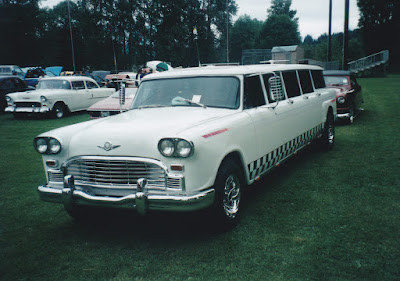Sunday, October 21, 2018
1946-1952 Bentley Mark VI Standard Steel Sports Saloon
Bentley was founded in 1919 and was purchased by Rolls-Royce in 1931, at which point Bentleys were simply sportier versions of Rolls-Royces. The Bentley Mark VI was introduced in 1946 as Bentley's first post-war model, and was based on the new Rolls-Royce Silver Wraith, also introduced in 1946, but while the Silver Wraith was only available as a chassis for custom coachwork, the Bentley Mark VI was available from the factory with completely assembled and finished all-steel coachwork, a first for Rolls-Royce. Called a Standard Steel Sports Saloon, this same body would be used to introduce the Rolls-Royce Silver Dawn in 1949. The Bentley Mark VI was powered by a 4.3-liter F-head inline 6-cylinder engine. In 1951, the bore was increased to raise displacement to 4.6 liters. The Bentley Mark VI was produced until 1952, and was then replaced by the new Bentley R Type. I am not sure what year the example pictured here is from (judging from the wheels, it might even be a replica).
Labels:
Bentley,
Clatskanie 1999
1962-1974 Checker Aerobus
This extremely long vehicle might look like an aftermarket stretch limousine conversion, but in fact it is a factory production model. The Checker Motors Corporation of Kalamazoo, Michigan, was best known for the production of taxicabs, though the company also sold cars for other commercial use and even to consumers as personal vehicles. Following the 1961 introduction of the new Marathon 4-door sedan and station wagons, in 1962 Checker introduced an extra-long wheelbase version of the station wagon called the Aerobus. Intended for use as an airport shuttle, the Aerobus was available in both 9-passenger 6-door and 12-passenger 8-door versions. More than merely a stretched Marathon, the Aerobus was designed as a limousine, though it still had many parts in common with the Marathon. While the Marathon was introduced with a Continental inline 6-cylinder engine, the Aerobus was initially powered by a 5.2-liter Chrysler V8, though when the Marathon switched to Chevrolet engines in 1965, the Aerobus followed suit. Production of the less-popular 9-passenger version ended in 1969. The Aerobus was initially dropped after 1974 when Checker discontinued the Marathon station wagon, but was revived for 1975 and 1976 with a sedan rear-end before being discontinued for good. The 12-passenger station wagon pictured here represents the most popular configuration Aerobus configuration, and Checker made few external changes to its vehicles from year to year, so there's little to identify what year of Aerobus production this example is from.
Labels:
Checker,
Clatskanie 1999
1981-1987 Lotus Turbo Esprit
The Lotus Esprit was first introduced in 1976. With a fiberglass body and 2.0-liter inline 4-cylinder engine, it received its first redesign in 1978. In 1981 it was redesigned again, this time more extensivley, receiving a 2.2-liter inline 4-cylinder engine. 1981 also saw the introduction of the Lotus Turbo Esprit, using a turbocharged version of the 2.2-liter engine. This generation of the Esprit continued until 1987 when it was redesigned, and the Esprit remained in production until 2004 for a total of 28 years. Each generation of the Esprit saw few external changes from year to year. Pictured here is a Turbo Esprit from the third generation, from 1981 to 1987.
Labels:
Clatskanie 1999,
Lotus
1982-1991 Jaguar XJ-S HE
The Jaguar XJ-S was originally introduced in 1975 as a replacement for the XK-E, which had been in production since 1961. The XJ-S was powered by the same 5.3-Liter V12 engine that had been introduced in the XK-E in 1971. Sales were slow, and in 1982 the XJ-S was redesigned and rechristened the XJ-S HE, featuring a new High Efficiency 5.3-Liter V12 engine that produced more power and torque while delivering better fuel economy. The new engine along with styling changes made the new XJ-S much more appealing, and sales increased dramatically. The XJ-S HE Coupe would see little change through 1991, though there were some additions to the line. Starting in 1983, a 3.6-Liter AJ6 inline 6-cylinder engine was also available, and this engine was used to power the XJ-SC cabriolet that was introduced that same year. The XJ-SC became available with the HE V12 in 1985, and was replaced by a full convertible in 1989. The XJ-S would receive a facelift in 1992 and was renamed the XJS; in this final form it would continue in production through 1996, for a total of 21 years. Pictured here is the XJ-S with the High Efficiency 5.3-Liter V12 engine. Exterior styling was virtually unchanged from 1982 to 1991.
Labels:
Clatskanie 1999,
Jaguar,
XJS
1955 Studebaker Ultra Vista 4-Door Sedan
In 1955, Studebaker gave a facelift to its 1953 styling for the last time before a major redesign in 1956. The 1955 Studebakers were introduced in the fall of 1954, but received an update in January of 1955. Most notably, the "flat" sloping windshield was replaced with a more upright wraparound design that Studebaker referred to as "Ultra Vista." Pictured here is an Ultra Vista 4-door sedan. It is either a Champion Deluxe or a Commander Deluxe. Commander had been Studebaker's top-line model, but the introduction of the new Studebaker President in 1955 bumped the Commander down to a mid-price position. The Commander and the Champion were now very similar, with the main difference being the engines: the Champion was powered by an L-head in-line "Victory Six," while the Commander had a more powerful V8 "Bearcat" engine.
Labels:
1955,
Clatskanie 1999,
Sedan,
Studebaker
Subscribe to:
Posts (Atom)










